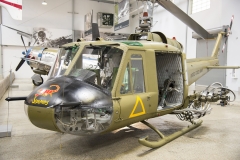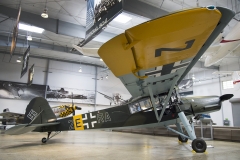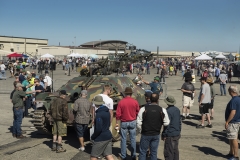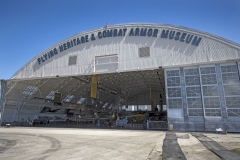A visit to the Flying Heritage & Combat Armor Museum
I was literally stuck between a rock (several actually) and a hard place. I was alone, unarmed, a little hungry and in the middle of no man’s land. My objective was a kettle corn stand, which I could not only see but smell, a mere 150 yards out in front of me. As I searched the sky for much needed air cover, like the B-25 Mitchell, de Havilland Mosquito, and Goodyear FG-1D Corsair I had seen flying earlier, the first sound of danger came from the roar of a German 88 mm Flak gun as a cloud of grey smoke belched from its long, camouflaged barrel. Capable of hurtling a 20-pound explosive shell more than 30,000 feet into the air, it was the scourge of Allied bomber formations.

Once the smoke had cleared I thought about making a dash for it, that was until the clattering of a mottled green, brown, and tan colored German Hetzer tank destroyer located to my left, began kicking up dust and gravel as its metal treads dug into the soft ground. Firing a single round in my direction, small pieces of gravel bounced across the rock ledge I was attempting to hide behind.

I knew it would only be a matter of time before they zeroed in on my position; where were those fighters and bombers? As I cautiously peered over the rock wall, my eyes bouncing back and forth between the German tank and the growing line of kettle corn customers in the distance, a flash of movement caught my right eye; a dirty white-colored Russian T-34 tank was about to engage the German Hetzer.

I don’t remember which happened first: seeing the smoke or feeling the vibrating concussion of the round zipping over my head as I was showered by bits of gravel. All I recall was that it was very loud, very real and I was glad it was make-believe. But I was also glad that I was able to step back into a brief moment in time and watch history come to life.
I had spent the last two days with the staff of Paul G. Allen’s Flying Heritage & Combat Armor Museum (FHCAM), located just north of Seattle at historic Paine Field in Everett, Washington, as they prepared for one of their many open house, public welcome events. Established in the 1990s to preserve icons of technology born from turmoil, the collection, which was initially housed in an old Air Force hangar has grown to encompass not only historic aircraft, but ground weapons as well. With the collection continually expanding, a second hangar was built to accommodate the influx of new rare and exotic historic airplanes. That growth continues, unabated; during my visit, I was shown the footprint of the new third hangar, which will break ground for construction in the upcoming weeks. Although the tanks and artillery pieces were historically accurate and most still functioning, it was the aircraft I was most interested in seeing in their natural element.
Unlike most museums where collections of aircraft are placed beyond arms reach, and dusted with fine cloth, the FHCAM birds get to spread their wings and fly on a routine basis. Stepping out onto the ramp I witnessed former foes lined up next to one another as they waited their turn to have their engines cranked up, taxi out, and fly. On the morning of my arrival the Mitsubishi A6M3-22 Zero belched white smoke from its radial engine as the newest FHCAM stablemate, a dark blue colored Goodyear FG-1D Corsair, also roared to life as the two taxied out behind a pair of rare Luftwaffe fighters — a Messerschmitt Bf 109 and Focke-Wulf Fw 190. As if that wasn’t enough for a history overload, a black-bellied twin engine de Havilland Mosquito joined the gaggle as they all slowly S-turned their way to the active runaway to depart for a photo flight.





The only thing that kept the Hawker Hurricane, Supermarine Spitfire, P-51D Mustang, and P-47 Thunderbolt on the ground was the lack of qualified pilots; they were all piloting the above-mentioned airplanes. They would, however, all take turns flying later that day, as if to ensure no one airplane was left out of the mix. Unfortunately, not all of the airplanes were able to fly during my visit. I would have enjoyed seeing the Grumman F6F Hellcat and the Russian Ilyushin IL-2M3 Sturmovik grace the Washington skies. Then again, the Fieseler Fi 156 Storch or the two-seat MiG-29 UB Fulcrum would have made my day, as would any of the countless other aircraft in the collection. But like the song says, “You can’t always get what you want. But if you try sometimes you get what you need.” Visiting the Flying Heritage & Combat Armor Museum made me realize something very quickly; I need to come back soon!
For more information about the Flying Heritage and Combat Armor Museum, visit them online.







